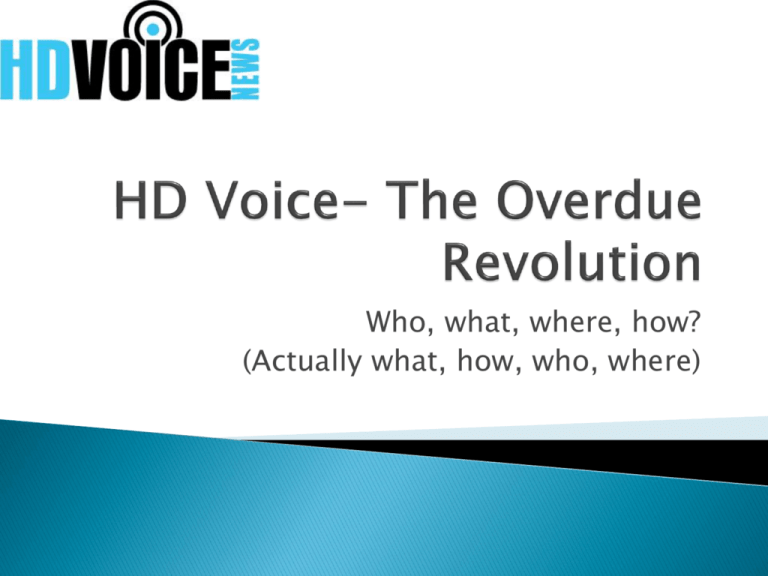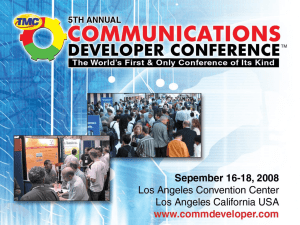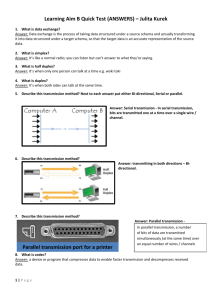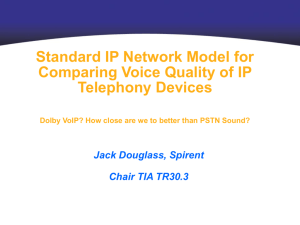here - HD Voice News
advertisement

Who, what, where, how? (Actually what, how, who, where) Following the ICT sector for over two decades Writing for Boardwatch, The Inquirer, VON Magazine (Pulvermedia), TMC Started HD voice coverage in May 2009 Launch of HD Voice News (HD Connect Now) in August 2009 France Telecom deployments ◦ Broadband: Over 500,000 G.722 VoIP endpoints ◦ Mobile: AMR-WB deployed in Moldova Global Crossing ◦ Built HD conference bridge for customer ◦ Working on open HD conferencing bridge Verizon Business ◦ Close to 5,000 phones at HQ ◦ Expects early adopters in 2010, general availability in 2011 Cablevision (Optimum Lightwave) ◦ Deployed hosted HD voice service in 2H09 Once again, the United States of America is being outclassed by the rest of the world in telecommunications technology…. U.S. carriers will wait until the smoke clears and then get a deal because someone else has done the hard R&D… What you get on nearly every POTS (wired or wireless) call today around the world ◦ Ignoring ISDN and the mobile HD deployments… PSTN grade call = captures3.4 kHz range ◦ 300 Hz to 3400 Hz Top “range” of human hearing clipped by 2/3 PSTN (POTS) acoustic standards set in 1937 ◦ Since then: FM radio, TV, CD, DVD, HDTV, HD radio… VoIP equivalent is G.711, 64 kbp/s bandwidth User interface/hardware ◦ ◦ ◦ ◦ Rotary dial to push buttons Pulse to tone Corded to cordless Wired to 4 plug to RJ-11 Plug boards to direct dialing Network ◦ Crossbar switch to SS7 to IP Also known as “wideband” voice Range of at least 7 kHz ; i.e. 2x of 3.4 kHz G.722 codec is the baseline for HD voice: ◦ 30 Hz to 7000 Hz ◦ Still only need 64 kbit/s due to compression Other HD voice codecs include AMR-WB, SILK, GIPS iSAC. HD voice only operates on a digital/IP network; POTS can’t handle it! Codec that samples at near full range of human speech ◦ 8 kHz sampling for narrowband ◦ 16 kHz for wideband ◦ 24 kHz for superwideband Marketing speak for “We’re better than G.722” in many cases Comes close to delivering “true voice” 25000 20000 15000 10000 5000 0 First third: Narrowband (G.711) Middle: G.722 HD voice Finish: “superwideband” in G.722.1C Biggest clarity jump is from G.711 to G.722 Improvement from G.722 to G.722.1C Non-native English speaker provides clear example of the benefits of HD voice Better compensation and clarity ◦ Similar-sounding words like "sail" and "fail" garble under narrowband ◦ Acronyms are “notorious” for garbling End up having to repeat and/or spell out ◦ Narrowband big headache in multilingual setting Reduction of fatigue - Why conference calls suck ◦ Narrowband clipping means brain plays “fill in the blanks” as a background task ◦ More audio data = less brain strain Codec, software, hardware, network, IP/SIP interoperability An all-IP (SIP) application Requires capable speakers & microphones ◦ Analog PSTN can’t be backfitted Need good QoS, low latency on network ◦ If you can’t do vanilla VoIP, you aren’t going to do HD For scaling, need agreements to interconnect via SIP for seamless HD calling & transcoding G.722 AMR-WB / G.722.2 ◦ Based on G.711, patents expired, now anyone can use it ◦ ◦ ◦ ◦ Cellular industry wanted codec based on AMR Designed to conserve RF usage, 24 kbit/s for HD Need to pay VoiceAge (and Nokia, FT, Ericsson) for patent use Currently exclusively in cellular domain, but being pushed for wireline iSAC SILK ◦ Google BOUGHT GIPS in May for $68 million ◦ Licensed for use by AOL, Yahoo, QQ, Nimbuzz, WebEx, IBM Lotus, Citrix Online ◦ Will Google open source one or more GIPS HD voice & video codecs??? ◦ Skype wanted “superwideband” codec with variable bit-rate adaptability based on CPU and network availability ◦ Royalty-free license, samples between 8 to 24 kHz, use 6 to 40 kbit/s G.722.1 / Polycom “Siren” Fraunhofer Audio Communication Engine (ACE) ◦ Royalty-free usage, not open source. ◦ Bit-rates from 16 to 32 kbit/s ◦ Billions of minutes of usage on Vivex. ◦ Include specifically designed MPEG codec “AAC Enhanced Low Delay” “CD quality audio” at “very low coding delays and bitrates” ◦ Pitched for 4G/LTE usage, other parts of toolkit include echo control software, IP streaming stack and error concealment tools. ◦ Why yes, you do have to pay royalties Speex Broadcom BroadVoice ◦ Open source patent-free ◦ Sampling from narrowband (8 kHz) to wideband and ultrawideband ◦ Can use bitrates from 2 to 44 kbit/s ◦ Offered royalty-free and open source under GNU (C, floating & fixed, GNU LGPL 2.1) ◦ Wideband at 16 kHz sampling, 32 kbit/s, narrowband 8 kHz sampling, 16 kbit/s Developers Hardware designers Wireless crowd ◦ Programmers all think they can write something better. ◦ Simpler is better, fewer codecs, less expense to test and support ◦ On device side, less processing = longer battery life ◦ Lean on the device CPU to compress (AMR-WB, SILK) ◦ Old guard: Every little RF bandwidth is sacred This goes out the door with 3G/4G!! 64 kbp/s is zippy! Said with a straight face as carriers intro streaming video, two-way conferencing…yah, WTF Network core ◦ More codecs, more transcoding between formats ◦ Service providers want to avoid transcoding as it costs $$ & has lose some HD voice goodness in translation between HD codecs Cable companies, FT love CAT-iq for end-to-end G.722 Soft clients ◦ Plenty floating around supporting G.722, iSAC. One big one supporting SILK Hardware ◦ Desktop handsets Vast majority supporting G.722, some SILK, AMR-WB creeping in Need good acoustics – speakers and microphones ◦ Mobile handsets/devices Need good acoustics Dual mics in vogue for echo/noise cancellation Simple case: Same codec type ◦ On same LAN/network – No sweat ◦ Beyond WAN/firewall - Interconnection via SIP Different codec types – Transcoding ◦ HD voice to PSTN/G.711/G.729 PSTN not going away; carriers understand But if you have to touch the PSTN, HD goodness goes away as you downshift to narrowband ◦ G.722 to AMR-WB, SILK, iSAC Service providers annoyed, but accept eventual need to transcode between codecs (G.722/AMR-WB big one) To scale, everyone has to interconnect via SIP for seamless end-to-end HD calls calls Service providers don’t do SIP peering/interconnect/federations out of the box◦ ◦ ◦ ◦ Security considerations (SPIT, DDoS, you name it) ENUM is overhead Quality of Service Settlements & least-cost routing (i.e. who gets cash) As a result, there are many HD voice islands: ◦ In enterprises ◦ At service providers Can peer (direct relationship) ◦ Service provider to service provider Interconnection (Federation) service ◦ Spoke and hub network with hub service managing ENUM, technical, business, and legal issues Interconnect automagically via Cisco IME Xconnect (www.xconnect.com) Global Alliance ◦ HD voice trial 2Q10 (i.e. NOW)… still going on. ◦ Needs to make a clear value proposition Small universe, service providers don’t want to pay Sprint PIN (Partner Interexchange Network) ◦ Currently vanilla VoIP, but capable of bigger things ◦ Handles price on per-minute cost for now ◦ Architecture can handle full range of rich media (voice, HD, video), but managers still wrestling with concept beyond simple VoIP. BYPASSES hub/spoke & service provider mediation Appliance handles virtualized peer-to-peer connections Currently only works with Cisco products; hopes proposed IETF standards proliferate to others Gen 1 box “manages” up to 10,000 or up to 40,000 phone numbers/devices – designed for large enterprises Each IME publishes phone numbers to dynamic hash table capable of handling up to 10 billion entries. After first “shared secret” PSTN call, IMEs conduct authentication process and exchange security particulars Subsequent calls routed on “virtual SIP trunk” and can be vanilla VoIP, HD voice, video or anything else SIP. One creator of ViPR & IME former Skype employee, so you can see where the peer-to-peer comes through. Layer 8 – Money ◦ Voice providers used to termination, per-minute LD ◦ Flat rate makes old telcos tilt a little ◦ Service providers reluctant to pay $$$ for currently small universe of HD calls ◦ Verizon Business providing free SIP calls in VIPER VoIP service to its customers Layer 9 – Politics ◦ Lot of jockeying by smaller players for peering ◦ Larger players moving slowly to IP interconnect Cable companies will likely do this next year Conferencing the “Killer App” ◦ Clarity, less stress, identify voices, accents less of a barrier Multi-national conversations for bonus dollars ◦ Non-native speakers of language can Be understood better Better understanding of what is being said Transcription (i.e. voice to email) ◦ Computer-based fewer errors ◦ Human, same thing, easier, less replaying Better IVR/anything processing voice Young and old ◦ Young (under 3) have squeaky voice, don’t understand on a phone call ◦ Old, don’t hear so well; HD adds back some clue Public safety/national defense ◦ Better 911 calling ◦ Better translation/understanding of intercept Yes, we want the enemy to have the latest tech… Major Telecom Carriers Mobile Carriers Cable/MSO Hosted VoIP/Business VoIP Consumer bypass play By region: ◦ Europe now ◦ Asia beginning ◦ North America “under the radar.” France Telecom Verizon ◦ At least 500,000 users/end-points on broadband ◦ Internally - nearly 5,000 endpoints installed at NJ HQ ◦ Verizon Business - “Early adopters 2010, general availability 2011” VIPER (VoIP enterprise service) will support G.722 by end of 2010 BT Telstra Global Crossing Others rumored: Telecom Italia, Nordic telcos, AT&T ◦ BT Hub, around 2 million G.722 capable end points deployed ◦ Hosted HD service for businesses; up to 11,000 end-points internally ◦ Running HD conferencing bridge for top-tier customer ◦ Public HD conferencing bridge coming ◦ Often repeated, but never verified France Telecom / Orange ◦ ◦ ◦ ◦ Moldova, Armenia (!) running today France “by end of July” NOW UK trials done, rollout “later this summer”/3Q Belgium, Luxembourg, Spain in 2010; bet on Tunisia SFR ◦ Testing in France now, service up by fall 3 UK ◦ Demo, teased media in 2010 Deutsche Telekom (DT) ◦ Has trialed HD on LTE “3G+”, VoLGA and 4G expected to be drivers CableLabs has issued multiple standards relating to HD Voice ◦ DECT CAT-iq in 2009, 2.0 standard in June End-to-end G.722 call, with DECT 6.0 wireless at end-user CPE with embedded CAT-iq starting to come in pipeline ◦ IP Interconnection standard released in June has ENUM defined Cablevision/Optimum Lightpath hosted HD service now Cox -“2011” is latest word. Comcast ◦ The Cable Show 2010, CTO said “As we move to HD voice…” Time-Warner Cable - Has tested HD voice, coy on deployment plans ◦ Expects CPE to be capable “within 5 years…” For all cable, enterprise drive HD ◦ SIP trunking, Hosted Many independent hosted providers ◦ Differentiator against bigger players 8x8 biggest in North America ◦ Aastra Hi-Q upgrade ◦ 70,000+ end-points (Jan 2010) Numerous players w/2,500 to 7,500 end-points. Lot of talk among smaller guys for direct peering ◦ IP Peering Alliance Independent hosting business VoIP service providers ◦ Cloud Communications Alliance Smaller group 8 in IP Peering Alliance talk more formal Ooma -Hardware/service bundle ◦ ◦ ◦ ◦ Second-generation Telo hardware can support G.722 & CAT-iq 4Q 2009 shipped 25,000 units Do the math, conservatively ship around 100K+ units in 2010 BUT, ooma took a left turn; now about narrowband VoIP quality WorldGate Vivox ◦ Guys who did the OjO phone ◦ Two year, 300,000 unit deal to ship videophones to ACN; the phone supports G.722 as well as video. ◦ Provides voice via Siren 14 (G.722.1C) to MMORPGs & Second Life ◦ 16 million users, Over 2 billion minutes per month ◦ Customers include CCP Games, Electronic Arts, Gaia Online, Icarus Studios, Linden Lab, NCsoft, Realtime Worlds, Sony Online Entertainment and Wizards of the Coast. Europe ◦ FT leading, others joining. Asia ◦ Australia/Telstra offering hosted service ◦ Korea, Japan offering services; hard to tell what North America ◦ “Under the radar” with earlier adopters in enterprise, consumer, cable, and hosted VoIP. Africa, South America ◦ Good potential in greenfield 3G/3G+ projects Service provider attraction/retention Conferencing Multi-national As a part of a UC play Higher education Attraction ◦ Better quality voice than narrowband, other carriers Retention ◦ Better quality product keeps people from switching (i.e. keep churn down) ◦ France Telecom not charging extra for bband HD Differentiation ◦ Set apart from everyone else… until everyone else gets it Monetization ◦ Pay for better quality (?) Nobody knows Pre-pay vs post-pay interesting to watch Clearer communication ◦ Don’t have to repeat acronyms Less stressful ◦ People focus on content, not figuring out what is being said Can identify individual voices easier BIG winner for Fortune 500/international businesses Non-native speakers can understand what is being said better/easier ◦ Clearer speech, no clipping of similar sounds, don’t have to guess/interpret Can understand non-native speakers better ◦ Accents much less of a factor because there’s no clipping. Rolled in as “yet another feature” in a UC play Better voice quality provides ◦ Clearer voice mail messaging ◦ More effective transcriptions Voice to email Less human work/intervention in voice-based work products (Health care, legal, financial) ◦ Cablevision/Optimum Lightpath’s play in NY Desire to work with “leading edge” Large campus deployments Deployments of 5,000 (and more) end-points ◦ Penn State ◦ Texas Tech Service Providers ◦ BT, Cablevision, France Telecom, Verizon Business, 8x8 IP desktop handset manufacturers – ALL of them ◦ Aastra, AudioCodes, Avaya, Cisco, Polycom Mobile handset manufacturers ◦ Nokia, Sony Ericsson declared, others in pipeline Network core Aculab, Cisco, Dialogic,Ericsson Applications ◦ BroadSoft, CommuniGate, Unisys, WYDEVoice Macro picture of HD voice Mobile HD voice progression Broadband Today ◦ Technology available in abundance ◦ Lots of HD islands Near-term ◦ IP interconnection is coming Hurdle is getting past Layers 8 & 9 (money * politics) Longer-term ◦ Superwideband become a codec/CPE upgrade If people want it… Mobile HD voice to happen faster France Telecom taking lead role in Europe ◦ Typical handset lifecycle of 3 years ◦ Arms race (more features) and Moore’s Law (faster/cheaper silicon) aid process ◦ Bringing handset manufacturers in Expects full portfolio to be AMR-WB capable by end of 2011 Competitors (SFR) starting to match in Europe Asia – likely Japan, Korea North America – Roll some dice… ◦ Info hard to come by; anyone have a source? ◦ Qualcomm pushing CDMA-based solution with its nonstandard codec Europe ◦ Orange and BT biggest deployments ◦ Virgin likely, Norway and Holland also cited as working on it ◦ Look for “superwideband” to happen first in Europe U.S. – Verizon/AT&T vs. Cable Companies ◦ Cable appears to be on a path for GA in 2011-2012 Approved DECT CAT-iq 2.0, ENUM in June 2010 CPE gear starting to come out in 2010 ◦ Once one side comes in, others expected in “avalanche.” Asia ◦ Korea, Japan www.hdvoicenews.com TMC (www.tmcnet.com) has a HD voice “Channel” with info www.mjgraves.org – Graves on SOHO ◦ The guy who provided the YouTube demo clips Phone.com also has some HD voice info, demos Twitter: DougonIPComm Email: dmohney@hdvoicenews.com Web: www.hdvoicenews.com Questions?








